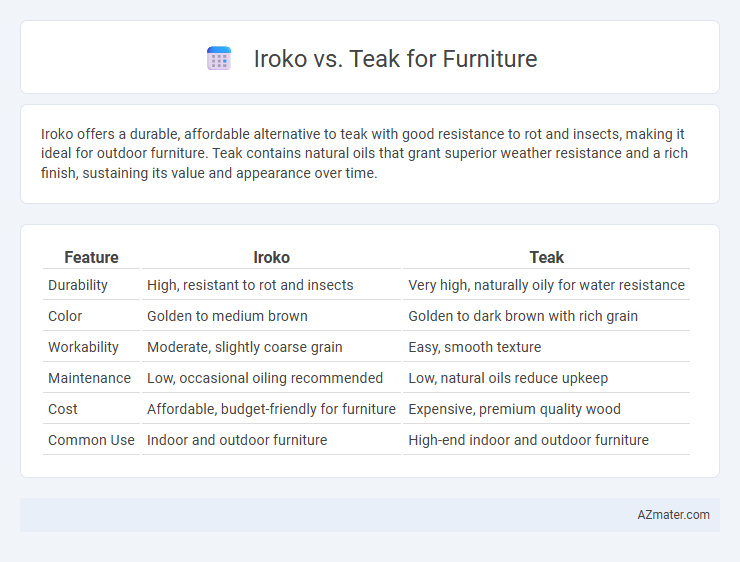Iroko offers a durable, affordable alternative to teak with good resistance to rot and insects, making it ideal for outdoor furniture. Teak contains natural oils that grant superior weather resistance and a rich finish, sustaining its value and appearance over time.
Table of Comparison
| Feature | Iroko | Teak |
|---|---|---|
| Durability | High, resistant to rot and insects | Very high, naturally oily for water resistance |
| Color | Golden to medium brown | Golden to dark brown with rich grain |
| Workability | Moderate, slightly coarse grain | Easy, smooth texture |
| Maintenance | Low, occasional oiling recommended | Low, natural oils reduce upkeep |
| Cost | Affordable, budget-friendly for furniture | Expensive, premium quality wood |
| Common Use | Indoor and outdoor furniture | High-end indoor and outdoor furniture |
Introduction: Iroko vs Teak Furniture
Iroko and teak are two popular hardwoods widely used in high-quality furniture due to their durability and resistance to weathering. Iroko, often called African teak, offers a golden to medium brown color with a coarse grain, while teak is renowned for its rich golden hue and natural oils that enhance water resistance. Choosing between iroko and teak depends on factors such as budget, desired aesthetics, and the furniture's exposure to outdoor conditions.
Wood Origins and Botanical Profile
Iroko wood, originating from the Milicia genus native to West Africa, is known for its dense, durable hardwood with a coarse texture, ideal for outdoor furniture due to its natural resistance to decay and insects. Teak, from the Tectona genus found primarily in Southeast Asia, features a smooth grain and high oil content, making it exceptionally water-resistant and prized for luxury furniture and marine applications. Both woods belong to deciduous trees but differ significantly in their botanical characteristics, with Iroko offering a cost-effective alternative to teak while maintaining excellent durability.
Appearance and Color Differences
Iroko features a golden to medium brown color that darkens over time, often showcasing a coarse texture with interlocking grain for a unique visual appeal. Teak is renowned for its warm honey-golden hue that fades to a silver-gray patina if left untreated, characterized by a smooth, straight grain enhancing its luxurious look. The color stability and natural luster of teak typically make it a preferred choice for premium furniture, while iroko offers a more rustic and robust appearance.
Durability and Longevity
Iroko wood offers exceptional durability with natural resistance to rot and insect attacks, making it ideal for outdoor and indoor furniture exposed to varying weather conditions. Teak wood, renowned for its high oil content and tight grain, provides superior longevity and maintains structural integrity for decades, even in harsh environments. Both woods are prized for their strength, but teak's natural oils give it an edge in resisting moisture and decay, ensuring a longer lifespan for premium furniture pieces.
Workability and Ease of Crafting
Iroko wood offers moderate workability, with a coarse texture and interlocked grain that can challenge precision but holds nails and screws well, making it suitable for robust furniture crafting. Teak is highly favored for furniture due to its smooth texture, straight grain, and natural oils that ease cutting and shaping while enhancing durability and resistance to pests. While teak demands sharp tools and proper finishing to manage its oily surface, it generally surpasses iroko in ease of crafting intricate and polished designs.
Weather Resistance and Outdoor Suitability
Iroko wood offers excellent weather resistance with natural oils that protect against moisture, decay, and insect attacks, making it highly suitable for outdoor furniture in humid and rainy climates. Teak wood is renowned for its superior outdoor durability due to its high oil content and dense grain, providing exceptional resistance to water, warping, and UV damage. Both woods are ideal for outdoor furniture, but teak generally outperforms iroko in extreme weather conditions and longevity.
Maintenance and Care Requirements
Iroko wood requires minimal maintenance due to its natural resistance to rot and insects, making it ideal for outdoor furniture with occasional cleaning and oiling to preserve its appearance. Teak demands more regular care, including periodic oiling to maintain its rich golden color and prevent weathering, especially in high-moisture environments. Both woods benefit from protective finishes and proper cleaning routines to extend their longevity and enhance durability.
Sustainability and Eco-Impact
Iroko wood offers a highly sustainable option for furniture due to its rapid growth rate and abundance in West African plantations, reducing pressure on natural forests compared to teak. Teak, while prized for durability and water resistance, often faces deforestation concerns because of slow growth and high demand, leading to significant ecological impact when sourced unsustainably. Choosing FSC-certified Iroko or teak ensures responsible harvesting practices that minimize environmental damage and promote forest regeneration.
Cost Comparison: Iroko vs Teak
Iroko wood is significantly more affordable than teak, making it a popular choice for budget-conscious furniture buyers. While teak commands a higher price due to its superior durability, natural oils, and resistance to decay, iroko offers a cost-effective alternative with decent weather resistance. Choosing iroko can reduce initial investment costs by up to 50% compared to teak, though long-term maintenance expenses may vary.
Best Uses for Iroko and Teak in Furniture
Iroko wood is ideal for outdoor furniture due to its exceptional resistance to moisture, rot, and insect damage, making it perfect for garden benches, patio sets, and decking. Teak excels in indoor furniture applications, prized for its natural oils that provide durability, a smooth finish, and rich golden-brown hue suitable for dining tables, chairs, and cabinetry. Both woods offer longevity and strength, but Iroko's affordability and weather resistance make it better suited for exterior use, while teak's aesthetic appeal and oil content ensure premium indoor furniture quality.

Infographic: Iroko vs Teak for Furniture
 azmater.com
azmater.com